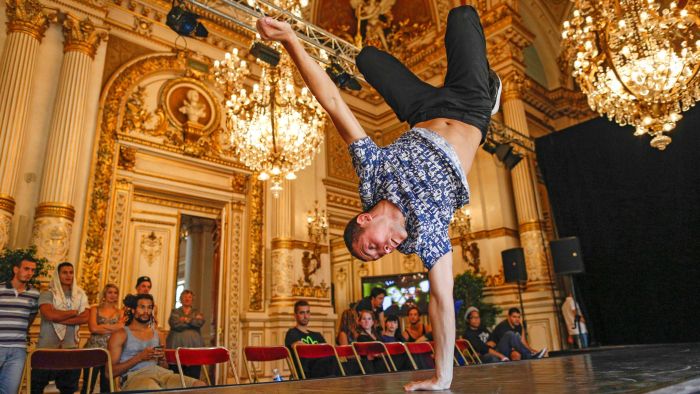Breakdancing is the latest event set to be added to the Summer Olympic Games, confirmed for Paris 2024.
It’s part of a concerted effort from the International Olympic Committee (IOC) to broaden the scope and appeal of the Games, which has prompted them to go on a veritable sport-adding spree in recent years.
The last Olympics in Rio saw golf return after a 112-year absence and rugby sevens join the schedule for the first time.
But that’s nothing compared to the Artist Formerly Known As The 2020 Tokyo Olympic Games, where five, six, seven or eight sports are being added to the slate, depending on how you count it.
So, with the news that B-boys and fly girls will be throwing their hands in the air before too long, here’s a quick look at what will be debuting or returning in Tokyo next year.
3-on-3 basketball
The profile of the discount version of traditional 5-v-5 basketball has grown in recent years, thanks to the Big 3 tournament in the US.
The league, co-founded by rapper Ice Cube, started in 2017 and featured a bevy of ex-NBA stars.
With obvious roots in pick-up basketball — played when it’s not possible or feasible to get 10 people together — 3-on-3 ball is played on a halfcourt and the winner is the first team to 21 or the team leading after 10 minutes.
Also similar to casual basketball is the scoring system, with the traditional three-point line serving as a two-point line and every bucket scored from inside the line worth just one point.
It was added to the 2010 Youth Olympics and there has been a FIBA-sanctioned World Cup since 2012. It will be played at the Summer Olympics for the first time in Tokyo 2021.
Skateboarding




When IOC president Thomas Bach was announcing the new sports approved for Tokyo, he came out with this very ‘How do you do, fellow kids?’ quote: “We want to take sport to the youth.”
“With the many options that young people have, we cannot expect any more that they will come automatically to us. We have to go to them,” he said.
The skateboarding competition features two disciplines — street and park.
- In street, competitors ride along a path with rails and boxes, performing flip tricks, grinds and slides on a course that resembles the sort of things you might see on, well, a street.
- In park, skaters are in a bowl-like course with steeper ramps and walls, allowing for more aerial tricks. Think of it like a gymnast’s floor routine.
You’ll see this in Paris as well as Tokyo.
Karate
According to the Tokyo 2020 website, karate has been trying to get into the Olympics since the 1970s but it wasn’t approved until 2015, when the IOC approved it for the Tokyo Games.
The Japanese martial art also has two competitions: kumite and kata.
- Kumite is your Karate Kid-style competition, where two karatekas try to beat each other in a sparring bout.
- Kata is demonstrating the forms and moves of karate, showcasing offensive and defensive movements targeting a virtual opponent.
The IOC and Paris organisers have not committed to having this at the 2024 Olympics.
Climbing




Sport climbing has broken into the mainstream thanks to documentaries like the Oscar-winning Free Solo and The Dawn Wall on Netflix.
If you follow many inner-city 20-somethings on Instagram, you might have seen some of them clambering up indoor rock climbing walls.
The Olympic program will be conducted over speed, lead and bouldering.
- Speed climbing pits competitors against each other on a set course that’s used all around the world, and whoever can fly up the wall and stop the clock the fastest gets the points.
- Lead climbing is done on a big wall where climbers have to clip their rope to carabiners in the wall as they go up and they’re measured by their highest clip-in point.
- Bouldering is done on lower walls without a rope and the moves are quick, powerful and technical. The aim is to complete the boulder “problem” in as few attempts as possible.
This will also be at Paris 2024.
Surfing
Australia will have a great shot at a medal when Tsurigasaki Beach hosts the first Olympic surfing competition at the 2021 Games.
As one of the world’s top surfing nations, along with Brazil and the US, Australia should have a number of potential champions in both the men’s and the women’s competition.
Seventeen of the past 22 women’s world championships have been won by Australians, and we’ve won four men’s world titles since 2007, although none since 2013.
Surfing will remain in the 2024 Olympics, with Paris organisers outsourcing the waves to Tahiti’s famous Teahupo’o break.
BMX freestyle




BMX was the IOC’s last apparent attempt to appeal to the X Games crowd, when it was introduced for Beijing in 2008.
BMX racing has been a fixture since then, but Tokyo will see the introduction of BMX freestyle.
Riders will have 60 seconds to do as many impressive tricks on a course like the arena used for the skateboarding park competition and judges will give scores based on the difficulty and execution of those tricks.
Baseball/Softball
Both sports are returning to the Olympic fold in 2021 after they were omitted from the London and Rio programs.
Baseball will only be contested by men, while softball will be strictly a women’s program.
Paris hasn’t committed to including either in 2024.







